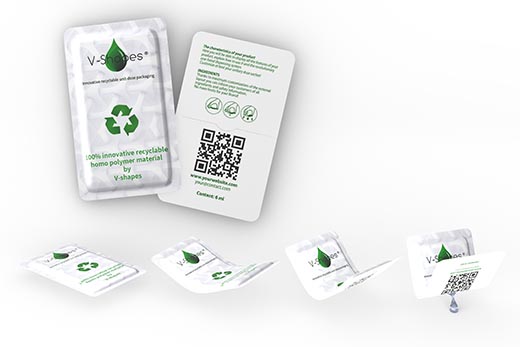V-Shapes: A Unique Story about Sustainability, Safety and Convenience in Packaging
Press release from the issuing company

- How to open a V-Shapes sachet. Single move with one hand. Easy!
As the climate crisis continues to evolve and governments around the world are paying more attention to sustainability initiatives and regulations, packaging will come under increased scrutiny for its role in adding to CO2 emissions, landfills and plastics pollution. Addressing this requires new thinking and a mindset of sustainability. Those are two of the founding principles of V-Shapes as the company continues to improve its single-dose sachet packaging machines.
But in this new, more environmentally conscious world, it can be tricky to balance the needs of consumers, converters/fillers, brand owners, and the planet. Clearly, brand owners want their packaging to convey a desired brand image, including through high-quality color, images and text. Converters/fillers are always developing new ways to serve their brand owner customers. Consumers look to packaging to identify the product they are purchasing or considering, and often seek to understand the sustainability profile of the brand owner. This can play a big role in purchasing decisions, especially with younger consumers. Consumers are also mindful of convenience and safety – with safety being an increased concern in light of what the pandemic has taught us! And with respect to the environment, it’s pretty clear that plastics are not going away anytime soon, so the ones we use should be able to operate within a circular economy.
At V-Shapes, we’ve taken all of those things into consideration and added a twist of uniqueness to bring cachet to our sachets! The brand owners we speak to love our unique approach to single-dose packaging that can be opened in a single move using only one hand. They love to be able to use high-quality printing on the sachets to promote their brand image and consumer messaging. And they like the fact that there is less product wastage as well as precise dosing and less space consumption in the shipping process compared to more conventional single-dose units. Conventional packaging of single doses often requires air headspace that takes up room and can have a deleterious effect on the packaged product shelf life.
Consumers love using leading-edge products that are different. They also like convenience. And as we get back to some semblance of normality as the pandemic ebbs, they will likely remain reluctant to use things like large condiment containers in event venues. They will instead be seeking a convenient way to continue to carry hand sanitizer and will be more conscious of other safety issues, in addition to overall sustainability.
We have given a lot of thought to the sustainability aspects of single-dose packaging. Most recently, we have achieved two important goals. First, TOMRA has verified that our sachets are detectable in industrial waste stream sorting as 100% polypropylene. This is important and means that used sachets can be sorted out of the waste stream for recycling.
All samples were easily identified by near infrared detection using a TOMRA AUTOSORT 4 detection unit. In addition to these samples being detectable as 100% polypropylene in the waste stream, TOMRA was also able to detect polypropylene below a thin high-barrier OPP layer used to prevent migration in some V-Shapes substrates.
In addition to the TOMRA verification, the prestigious auditing agency Interseroh tested two different V-Shapes proprietary substrates, reNEW-100 and reNEW X-500, for recyclability and issued certifications following successful tests.
V-Shapes also partnered with NatureWorks to offer their innovative Ingeo substrate as an option, which we are marketing under the brand V-Green. INGEO polymers are certified as compostable according to EN13432. TÜV Austria has certified that “bio-based V-Green” features between 60% and 80% bio-based carbon content, a three-star rating. This enables us to use the “OK BIOBASED” conformity mark with our V-Green biobased substrates.
Experts tell us that there is a difference between recyclability and compostability, and we want to be able to offer both. The polypropylene we use can be directed to a variety of applications after it is sorted out of industrial waste streams, including being chopped up for use in other products such as carpets. For a material to be classified as compostable, it needs to be 90% biodegradable and compostable within 90 days, and elements that come from the breakdown of the material should be nontoxic and natural so the final compost does not contain any toxic material.
That’s why we have made a variety of substrates available so that the concerns of converters/fillers, their brand owner customers, the consumers of the final product and government regulatory agencies can all be satisfied.
In addition, for printing on our sachets, we use water-based inks that can be removed in the washing process, typically in recycling polypropylene – or composted without leaving behind toxic materials in the case of V-Green. We have been able to address two other concerns as well – efficient sealing and prevention of ink or other material migration into packaged product. Even when put under pressure in applications like magazine tip-ins with samples, placed in a purse or a pocket, our sachets do not leak. And we use a very thin high-barrier OPP layer as appropriate to prevent migration – a layer that does not affect detection, as shown in the TOMRA results, or recyclability.
At V-Shapes, we have spent a great deal of time making sure we are serving each and every one of the various stakeholders in the packaging life cycle in the best possible way.
Whether a brand owner is looking for unique packaging, or a converter/filler is looking for a solution to make their customers stand out, V-Shapes is here to help – either by providing equipment or by connecting with one of their partners close by!
To learn more about the approach and how our innovative sachets can revolutionize the way people think about single-dose packaging, visit www.v-shapes.com
© 2025 WhatTheyThink. All Rights Reserved.













